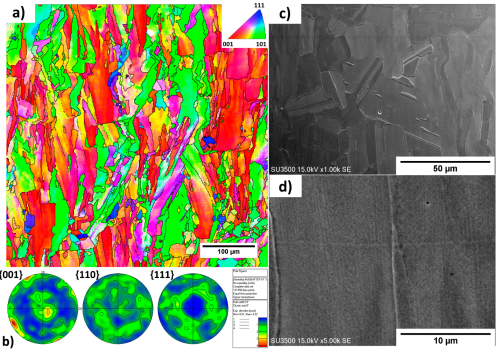
Representative optical micrograph of stitched 50× images from the cross-section of an as-built cubic sample from its polished state.
Hastelloy X is a nickel alloy that is categorized as weldable, yet tends to crack during additive manufacturing. In addition to nickel, the material also contains chromium, molybdenum and iron, and it has been theorized that the specific concentrations of each metal may have something to do with its tendency to crack. The additive manufacturing industry has been focusing on formulating a crack-free version of Hastelloy X, and in a new paper entitled “Fabrication of Crack-Free Nickel-Based Superalloy Considered Non-Weldable During Laser Powder Bed Fusion,” a group of researchers successfully processed the alloy via additive manufacturing without cracking. Furthermore they did this without having to change the material itself.
The Hastelloy X powder was obtained from LPW Technology and processed using a Renishaw AM400.
“The powder particles were spherical in morphology, having a particle size distribution D10 = 19 µm, D50 = 41 µm, and D90 = 62 µm,” the researchers state. “Cubic samples of 1 cm3 were produced under Ar atmosphere and analyzed in the as-built and annealed condition.”

(a) SEM montage of the cylindrical sample and higher magnification images of the (b) top, (c) middle and (d) bottom of the sample. The regions where (b-d) were taken from are highlighted on the montage.
Cross-sections of samples were prepared for microstructure evaluation using traditional metallography techniques, and the samples were evaluated using electroetching, a light optical microscope, and scanning electron microscopes. Heat treatment was carried out for one hour followed by water quenching.
The testing showed that the material maintained a crack-free microstructure.
“Columnar grains parallel to the building directions were evidenced through EBSD in the as-built condition,” the researchers explain. “Likewise, a typical microstructure for LPBF Ni-based superalloys was found, with smaller columnar structure size than reported elsewhere in literature. The presence of Mo-enriched carbides (~50 nm) was confirmed through EDS line scans obtained using an FE-SEM; these Mo-enriched carbides are presumed to play an important role in the cracking mechanism of this alloy.”

(a) EBSD map taken from the central region of the sample after heat treatment; and (b) its corresponding pole figure; SEM micrographs taken at (c) 5000× and (d) 1000× showing the microstructure of the sample after heat treatment
Hastelloy X is a desirable material for a number of reasons. It possesses a high resistance to oxidation as well as high-temperature strength. While it may be prone to cracking during additive manufacturing, it is a remarkably resistant to stress-corrosion cracking when used in petrochemical applications. It also exhibits good ductility after prolonged exposure to high temperatures.
Because of its high heat and oxidation resistance, Hastelloy X is frequently used in industrial furnace applications, as well as in gas turbine engines. Its value as a material means that it is well worth the time and work involved to develop it for additive manufacturing, particularly as additive manufacturing becomes more and more important to the aerospace industry. Curiously, materials that have shown themselves to be crack-free during welding can still form cracks during additive manufacturing, so specific formulations of these materials must be developed for additive manufacturing. This particular paper shows that crack-free Hastelloy X can be successfully additively manufactured, which is promising for many applications in the future.
Authors of the paper include Oscar Sanchez-Mata, Xianglong Wang, Jose Alberto Muñiz-Lerma, Mohammad Attarian Shandiz, Raynald Gauvin and Mathieu Brochu.
Discuss this and other 3D printing topics at 3DPrintBoard.com or share your thoughts below.
Subscribe to Our Email Newsletter
Stay up-to-date on all the latest news from the 3D printing industry and receive information and offers from third party vendors.
You May Also Like
Profiling a Construction 3D Printing Pioneer: US Army Corps of Engineers’ Megan Kreiger
The world of construction 3D printing is still so new that the true experts can probably be counted on two hands. Among them is Megan Kreiger, Portfolio Manager of Additive...
US Army Corps of Engineers Taps Lincoln Electric & Eaton for Largest 3D Printed US Civil Works Part
The Soo Locks sit on the US-Canadian border, enabling maritime travel between Lake Superior and Lake Huron, from which ships can reach the rest of the Great Lakes. Crafts carrying...
Construction 3D Printing CEO Reflects on Being Female in Construction
Natalie Wadley, CEO of ChangeMaker3D, could hear the words of her daughter sitting next to her resounding in her head. “Mum, MUM, you’ve won!” Wadley had just won the prestigious...
1Print to Commercialize 3D Printed Coastal Resilience Solutions
1Print, a company that specializes in deploying additive construction (AC) for infrastructure projects, has entered an agreement with the University of Miami (UM) to accelerate commercialization of the SEAHIVE shoreline...





























